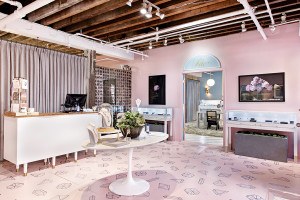The Real Artists’ Lofts
 Yesterday was dark, moody, with occasional downpours, a perfect backdrop for a trip to check out one of the strangest buildings I’ve ever stumbled upon in Boston. Squeezed between the Fenway and the turnpike is a creaky, century-old edifice built specifically for artists during the gilded age, called Fenway Studios.
Yesterday was dark, moody, with occasional downpours, a perfect backdrop for a trip to check out one of the strangest buildings I’ve ever stumbled upon in Boston. Squeezed between the Fenway and the turnpike is a creaky, century-old edifice built specifically for artists during the gilded age, called Fenway Studios.
Stepping in from the rain, I was greeted by a terra cotta tile floor, a wrought iron pendant lamp, and deep wood paneling. As my eyes adjusted to the dim light, I could see the elevator ahead—one of those expanding metal grate kinds that you can lose a finger in. All of which felt vaguely foreboding.
Once on a floor (there are four), the long hallway hosts an endless number of wooden doors, each with a unique knocker, some brass, so wood, which give a glimpse at the artist working within. Every unit has 14-foot high ceilings, a loft for sleeping, and boatloads of windows, all facing north for that perfect indirect light that artists adore. And each artist, some of whom have lived here for more than four decades, presents his or her own interpretation of what it means to be an esthete.
For a design hound like me, this is Christmas—I mean, room after room of artists, but not the “my parents are waiting for me to get a real job” kind? Not at all. This is the real deal—these people have handed their lives over to the creative muse.
My first stop is David H. Lowry’s studio. He is quite tall, with thick manic silver hair, and a face so dimensional it looks like a caricature. Lowry, who is fiercely intelligent but kindly, is obsessed with the Renaissance. He welcomes me into his mysteriously dark, dusty space adorned with heavy wood accents (all hand-carved by the artist), marble, and reams of velvets.
I’ve just stepped into Vermeer’s studio, complete with hand-made camera obscuras painstakingly recreated from 17th century drawings he dug up at Harvard University. Does anyone else know about this?
The artist has of late been obsessed with the Wizard of Oz. An absolutely precise reproduction of the tin man lies slumped in one corner; a life-sized scarecrow hangs from his cross on a platform.
And then there’s Yoshi Mizutani, who paints better than John Singer Sargent—with his large canvases and achingly lovely portraits. He’s in his gym clothes and looks like a graduate student, but he’s a massive talent. He fit out his space Japanese-style, with built-in wood drawers, cabinets, all carefully detailed. The walls exhibit his work in the soft, cloudy light. Is this a dream?
Fenway Studios is a relic and a godsend. It exists solely for artists and they protect the building with their lives. In the winter issue of Home, we will bring you a full-blown photo essay of these incredible spaces and the people who live there. I can’t wait for the photo shoot!
Image from Friends of Fenway Studio’s website.


